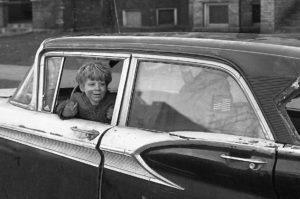 Kid in an Abandoned Ford, Uptown (from ChiTown Journal),
Kid in an Abandoned Ford, Uptown (from ChiTown Journal),
Chicago, by Bruce Berman. 1971
Text and Photograph by Bruce Berman
Working on my book Chitown Journal.
Digging ahead on this but it’s like a time tunnel to yesteryear. The deeper I dig the darker it gets. Not sure, even, why I’m doing this except that I like looking at the images. When you’re looking back a couple of generations you wonder how these people turned out. What happened? Any millionaires, murderers, poets, policemen, shrinks, grave diggers, photographers, Aldermen?
Can’t know. All that I have is images. They tell many things but never facts and never data.
And what am I now? This was 49 years ago? I was a pimpled unhappy warrior looking for a war and for myself. And I didn’t know it. All I had was moves (just average for a twenty three year old and a camera. I was expendable. I trudged through this wasteland every day, one camera, one lens, a roll or two of Tri X film, an army surplus parka and surplus combat boots. A surplus Norwegian army gas mask bag for my filters. extra film, lens cleaning tissues and er… some contraband). It was freezing half the year, but, I was out hunting for… for… I wasn’t sure what for, then.
I know even less now (but a little more than then).
Why was I here? Why not downtown in the clubs, young yuppies? Why not the good life? I had a college degree tucked in my footlocker, somewhere, but I wanted to live that whole life down. College itself was like a walk in another world and I started sinking the day I got there.
The name of the neighborhood that drew me in was called Uptown.
This was Appalachia north. Folks. From Tennessee, Kentucky, Ohio… all looking for work, looking for some way to make it, big families in tow, living in the ratholes of urban sub America.
Uptown.
It was the. most “multi cultural” neighborhood in America, some said. But there was more there than Appalachian Anglos: muchos Latinos (Puerto Rico, Dominica, Cuba), Native Americans (Chippewas, Menomonee’s, from the north, Apaches, Pimas and Navajos from the southwest), Blacks, up from the Mississippi Delta, not singing the Blues but living them, Asians, Chinese mostly, the ones that don’t have reestaurants but work in them without papers. Everyone was looking for work, for a first rung on the ladder, for a piece of America that wasn’t as obliterated as theirs’ had been, wherever they’d come from. No one spoke the “King’s English,” or even the nobles’ English, (you know, like college people, hipsters, the upper American middle class middle class).
Everyone was on the margins, the edge, teetering.
Marginalized. Funny language, funny clothes, funny customs, big families (which looked “dirty” and excessive to the beginning-to-shrink nobility class of middle and upper America), everyone scratching, fighting, slipping and sliding.
I didn’t know it then, but this was a border, a place that divides but also joins. A border. My first journey to no man’s land, the first of a very long journey trying to figure on which side of the line I’m supposed to be on… if any.
I was on their borderline, and my own slippery and undifferentiated was struggling to get onto dry land instead of the river of quick sand that I’d been bluffing my way through.
This was my last shot. At twenty three I already knew I was going nowhere and I’d already polluted down a few wrong paths and I was sinking and I knew it. I didn’t know where to be so I found myself in Uptown, Chicago, USA. America.
This was the beginning and the end of my life. This is where I’d leave the past and pray for a future.
It started with one camera, one lens, a couple of rolls of Tri X a wardrobe of cast off surplus clothes, a bad attitude and a landscape that lived behind the fog, invisible to my and its past.
I turned in my credentials. There was no leaving. I began to walk into the clouds without a clue of what was to come, hoping I’d come out with some answers.
These photographs, I suspect, were crumbs, clues to the answers to the questions I didn’t quite know how to formulate.
My life in photography began here, in Uptown, in 1970.
